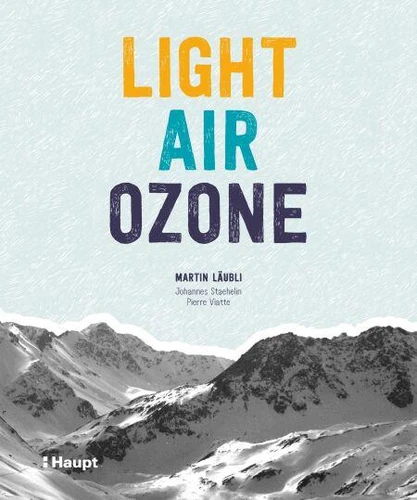Light, Air, Ozone
Par : , , ,Formats :
Disponible dans votre compte client Decitre ou Furet du Nord dès validation de votre commande. Le format PDF est :
- Compatible avec une lecture sur My Vivlio (smartphone, tablette, ordinateur)
- Compatible avec une lecture sur liseuses Vivlio
- Pour les liseuses autres que Vivlio, vous devez utiliser le logiciel Adobe Digital Edition. Non compatible avec la lecture sur les liseuses Kindle, Remarkable et Sony
 , qui est-ce ?
, qui est-ce ?Notre partenaire de plateforme de lecture numérique où vous retrouverez l'ensemble de vos ebooks gratuitement
Pour en savoir plus sur nos ebooks, consultez notre aide en ligne ici
- Nombre de pages180
- FormatPDF
- ISBN978-3-258-48210-1
- EAN9783258482101
- Date de parution05/10/2020
- Protection num.Digital Watermarking
- Taille37 Mo
- Infos supplémentairespdf
- ÉditeurHaupt
Résumé
Pioneers, troublemakers, discoveries.
The resort of Arosa became a world-renowned research centre.
This book tells the story of the world's longest series of ozone measurements and the Earth's vital protective envelope.
Where the Grandhotel Tschuggen now stands in Arosa was once the Arosa Sanatorium. In those days thousands travelled to the resort to recover from tuberculosis, a disease that was widespread at the time.
The German physicist Paul Götz launched his career on the roof of the sanatorium. At the request of the Arosa Resort and Tourism Association (Kur- und Verkehrsverein Arosa) he established the Light Climatic Observatory LCO (Lichtklimatisches Observatorium LKO) in 1921 to provide scientific validation of Arosa's reputation as a high altitude health resort. To this end Götz studied solar radiation, in which the ozone layer in the atmosphere played an important role.
This gave rise to the world's longest series of ozone measurements, and it remains important for international research to this day. The observatory only survived for just under a century thanks to the strong personalities of those involved. Since 1988 it has been run by MeteoSwiss. This richly illustrated book chronicles some of the history of research and the environment. It considers the pioneers of ozone research and looks at the current risks caused by the hole in the ozone layer and climate change.
The book tells the story in chronological order, but each chapter can be read in isolation.
The German physicist Paul Götz launched his career on the roof of the sanatorium. At the request of the Arosa Resort and Tourism Association (Kur- und Verkehrsverein Arosa) he established the Light Climatic Observatory LCO (Lichtklimatisches Observatorium LKO) in 1921 to provide scientific validation of Arosa's reputation as a high altitude health resort. To this end Götz studied solar radiation, in which the ozone layer in the atmosphere played an important role.
This gave rise to the world's longest series of ozone measurements, and it remains important for international research to this day. The observatory only survived for just under a century thanks to the strong personalities of those involved. Since 1988 it has been run by MeteoSwiss. This richly illustrated book chronicles some of the history of research and the environment. It considers the pioneers of ozone research and looks at the current risks caused by the hole in the ozone layer and climate change.
The book tells the story in chronological order, but each chapter can be read in isolation.
Pioneers, troublemakers, discoveries.
The resort of Arosa became a world-renowned research centre.
This book tells the story of the world's longest series of ozone measurements and the Earth's vital protective envelope.
Where the Grandhotel Tschuggen now stands in Arosa was once the Arosa Sanatorium. In those days thousands travelled to the resort to recover from tuberculosis, a disease that was widespread at the time.
The German physicist Paul Götz launched his career on the roof of the sanatorium. At the request of the Arosa Resort and Tourism Association (Kur- und Verkehrsverein Arosa) he established the Light Climatic Observatory LCO (Lichtklimatisches Observatorium LKO) in 1921 to provide scientific validation of Arosa's reputation as a high altitude health resort. To this end Götz studied solar radiation, in which the ozone layer in the atmosphere played an important role.
This gave rise to the world's longest series of ozone measurements, and it remains important for international research to this day. The observatory only survived for just under a century thanks to the strong personalities of those involved. Since 1988 it has been run by MeteoSwiss. This richly illustrated book chronicles some of the history of research and the environment. It considers the pioneers of ozone research and looks at the current risks caused by the hole in the ozone layer and climate change.
The book tells the story in chronological order, but each chapter can be read in isolation.
The German physicist Paul Götz launched his career on the roof of the sanatorium. At the request of the Arosa Resort and Tourism Association (Kur- und Verkehrsverein Arosa) he established the Light Climatic Observatory LCO (Lichtklimatisches Observatorium LKO) in 1921 to provide scientific validation of Arosa's reputation as a high altitude health resort. To this end Götz studied solar radiation, in which the ozone layer in the atmosphere played an important role.
This gave rise to the world's longest series of ozone measurements, and it remains important for international research to this day. The observatory only survived for just under a century thanks to the strong personalities of those involved. Since 1988 it has been run by MeteoSwiss. This richly illustrated book chronicles some of the history of research and the environment. It considers the pioneers of ozone research and looks at the current risks caused by the hole in the ozone layer and climate change.
The book tells the story in chronological order, but each chapter can be read in isolation.



